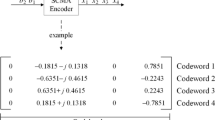Abstract
With the increasing needs of high data rate communication, spectrally more efficient communication schemes are desired. In multiuser communication context, conventional orthogonal multiple access (OMA) schemes suffer from spectral efficiency loss by fundamental information theoretics. Non-orthogonal multiple access (NOMA) schemes are more appropriate. In this paper, we propose a new NOMA system based on generalized energy spreading transform (GEST). We give the basic system structure and compare it with some existing NOMA systems. It is interesting that the proposed GEST-MA can be viewed as a generalization of several existing NOMA systems. Analysis and simulations show that GEST-MA is more flexible than current NOMA systems and is capable of achieving the potential diversity gain without sacrificing the spectral efficiency. Those properties make it a strong candidate for the next generation mobile communication systems.







Similar content being viewed by others
Notes
In general one can allocate different \({\mathbf {G}}_k\) to different users.
In IDMA, modulation is done after interleaving, but it can actually be shifted before spreading just as other NOMA systems.
In fact, DoCoMo-NOMA only considers the case in which \(J=1\) and thus no interleaving is involved. However, \(J\ne 1\) with interleaving does not change the underlining principles of the system.
References
Pekka, P. (2014). A brief overview of 5G research activities. In Proceedings of international conference on 5G for ubiquitous connectivity, pp. 17–22.
Chavez-Santiago, R., Szydelko, M., Kliks, A., et al. (2015). 5G: The convergence of wireless communications. Wireless Personal Communications, 83(3), 1617–1642.
Sodani, D., & Manzalini, A. (2015). Horizon 2020 and beyond: On the 5G operating system for a true digital society. IEEE Vehicular Technology Magazine, 10(1), 32–42.
Andrews, J. G., Buzzi, S., Choi, W., et al. (2014). What will 5G be? IEEE Journal on Selected Areas in Communications, 32(6), 1065–1082.
Zhang, S., Xu, X., Wu, Y., & Lu, L. (2014). 5G: Towards energy-efficient, low-latency and high-reliable communications networks. In Proceedings of IEEE international conference on communication systems, pp. 197–201.
Wang, C.-X., Haider, F., Gao, X., et al. (2014). Cellular architecture and key technologies for 5G wireless communication networks. IEEE Communications Magazine, 52(2), 122–130.
Chen, S., & Zhao, J. (2014). The requirments, challenges, and technologies for 5G of terrestrial mobile telecommunication. IEEE Communications Magazine, 52(5), 36–43.
Gavrilovska, L., Rakovic, V., & Atanasovski, V. (2015). Visions towards 5G: Technical requirements and potential enablers. Wireless Personal Communications, 1–27.
Ping, L., Liu, L., Wu, K., & Leung, W. K. (2006). Interleave-division multiple-access. IEEE Transactions on Wireless Communications, 5(4), 938–947.
Wunder, G., Kasparich, M., Brink, S., et al. (2013). 5GNOW: Chanllenging the LTE design paradigms of orthogonality and synchronicity. In Proceedings of IEEE vehicular technology conference (VTC spring), pp. 1–5.
METIS 2020. Mobile and wireless communicaitons enablers for the twenty-twenty information society. https://www.metis2020.com.
Qader, S. N., Tsimenidis, C. C., Johnston, M., & Sharif, B. S. (2014). Optimization of iterative DFE-IDMA detection for multipath fading channels. In Proceedings of IEEE wireless communications and networking conference, pp.1236–1241.
Guanghui, S., Yuta, T., Jun, C., & Yoichiro, W. (2014). Finite field spreading for multiple-access channel. IEEE Transactions on Communications, 62(3), 1001–1010.
Hwang, T. (2008). Multiple access with energy spreading transform. IEEE Signal Processing Letters, 15, 150–153.
Hwang, T., Kim, Y., & Park, H. (2012). Energy spreading transform approach to achieve full diversity and full rate for MIMO systems. IEEE Transcations on Signal Processing, 60(12), 6547–6560.
Hosein, H., & Hadi, B. (2013). Sparse code multiple access. In Proceedings of IEEE international conference on personal indoor and mobile radio communications, pp. 332–336.
Saito, Y., Kishiyama, Y., Benjebbour, A., et al. (2013). Non-orthogonal multiple access (NOMA) for celluar future radio access. In Proceedings of IEEE vehicular technology conference (VTC spring), pp. 1–5.
Hwang, T., & Li, Y. (2006). Novel iterative equalization based on energy-spreading transform. IEEE Transactions on Signal Processing, 54(1), 190–203.
Yuan, X., Ma, J., & Ping, L. (2014). Energy-spreading transform based MIMO systems: Iterative equalization, evolution analysis, and precoder optimization. IEEE Transactions on Wireless Communications, 13(9), 5237–5250.
Dang, J., Yang, L., & Zhang, Z. (2011). On grouped OFDM-IDMA. In Conference record of the forty fifth asilomar conference on circuits, systems and computers, pp. 1298–1303.
Mahafeno, I. M., Langlais, C., & Jégo, C. (2006). OFDM-IDMA versus IDMA with ISI cancellation for quasistatic Rayleigh fading multipath channels. In Proceedings of international symposium on turbo codes and related topics, pp. 1–6.
Author information
Authors and Affiliations
Corresponding author
Additional information
This work is supported by NSFC project (No. 61223001), 863 project (No. 2013AA013601), and Jiangsu NSF project (No. BK20140646).
Rights and permissions
About this article
Cite this article
Dang, J., Zhang, Z. & Wu, L. A New Framework for Non-orthogonal Multiple Access Based on Generalized Energy Spreading Transform. Wireless Pers Commun 91, 847–860 (2016). https://doi.org/10.1007/s11277-016-3500-9
Published:
Issue Date:
DOI: https://doi.org/10.1007/s11277-016-3500-9




